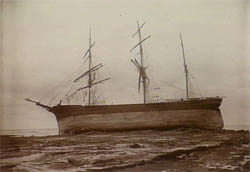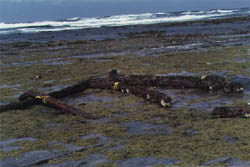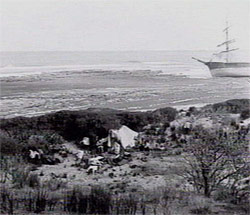|
||||||||||||||
|
|
||||||||||||||
|
|
The vessel was built at an estimated cost of 40,000 pounds. The British registered vessel is described in her original registry certificate as being 189.6 ft (57.8 m) long, 37.7 ft (11.5 m) in breadth and 22.4 ft (6.8 m) in depth. She was a 1155 ton (gross), single decked, three masted barque. The hull was of softwood construction and sheaved in felt and yellow metal. In 1897 the Lloyds Shipping Register records that structural modifications were made to the deck with two tiers of beams being added to the existing supports, structural improvements not surprising for a softwood vessel then approaching its seventeenth year in service. Whilst berthed in Manila the United States Government offered Thomson and Co. 4,500 pounds for the vessel however the offer was refused. The offer 1/9 of her original cost perhaps reflected the decline in the role of sail in a period when steam ships were coming to a forefront or more simply "the Artisan was a wooden ship and she has deteriorated" - Captain S. Purdy master of the Artisan; Comments Argus 23/4/1901. The Artisan left Manila, Philippines on 18 February 1901 under the command of Captain Samuel Purdy, a crew of 15 and one passenger the captain's wife who appears to have frequently gone to sea with her husband. Captain Purdy, 39 years and of Canadian birth had mastered the Artisan for the past six and a half years. The crew consisted of a variety of nationalities including English, Irish, Canadian, Argentinean and Filipino. It is more than likely that the Filipino crew were employed as cheap labor rather than skilled seamen particularly since the Board of Trade Inquiry subsequently revealed that a number of Filipinos could not speak English. The Wrecking
The master of the Artisan tried to beat against it through the Straits but the vessel being in ballast was to light for him to carry sufficient sail and the vessel made heavy leeway until finally forced steadily back over the same ground. The crew could do little but pray as the vessel was driven by the gale. On Monday the foul weather persisted and Captain Purdy was again unable to ascertain his position. All day, one by one the sails, though close reefed were carried away. Fresh sails were hoisted but these too were torn to pieces and at last the vessel was swept almost under bare poles towards shore. Efforts made to keep the vessels head to wind were unavailing and it was swept broadside on with waves breaking over her deck at every plunge. All night the barque was kept beating about, left to the mercy of the waves. At 3 am on Tuesday 23 April the wind and set of the sea had carried the Artisan broadside into huge breakers. The crew endeavoring to attract attention fired blue distress rockets. Driven slowly through the breakers their only hope was that the vessel might somehow get over the breakers and into deep water. Their hopes were short lived for suddenly they struck with a tremendous jolt shaking the barque from stem to stern.
The seas were now making a clean sweep over the deck. The crew clung to stanchions for fear of death as the Artisan began to bump and roll in a horrible manner. All hands made for the life boats but no one could tell if they had run ashore or were on reef some distance from the mainland and with the seas pounding it was decided that no boat could last five seconds so no attempt was made to lower one. The master ordered every stitch of remaining canvas to be set with intentions of driving inshore as far as possible. As daylight approached the rolling motion slowly subsided and to the relief of the crew they found that there was only some 100 yards of shallow water between the vessel and the beach. The Artisan had been forced as far as possible over the reef and was firmly stranded to all appearances intact apart for her sails. Standing in an almost upright position broadside to the beach with the bow heading a little southeast. The hull was sitting in 3 feet of water with the tide receding. Twelve feet of the hulls copper sheathing was exposed testament to the high seas previous. At low tide the crew and Mrs. Purdy 'walked' ashore taking a few of their personal effects with them. Miraculously there had been no loss of life. Fortunately for the crew a short distance away was the only habitation within ten miles of the wreck. The hut was the residence of Mr. Richard Jennings and his wife caretakers of the Cape Patterson Coal Mine.The first report of a ship ashore was at 7.30 am on Tuesday morning. Early that morning John Cleeland Junior, a member of the Newhaven-San Remo Rocket Corps had left Newhaven and made his way to the highest point on Cape Woolamai, a headland of Phillip Island. Suspecting that there was a strong probability of maritime disaster he swept the horizon with his glass and spied a vessel ashore at Cape Patterson approximately 20 miles eastward. Hurrying back to Newhaven he bravely ventured across the channel to San Remo and summoned the volunteer rocket corps for their first action. Constable O'Shannessy captain of the corps and Mr.T Bergin of the San Remo Hotel quickly secured for other members of the corps and 700 kilos of rocket apparatus. Acting under the instructions of Ports and Harbors Mr.C.W.Maclean they left San Remo. Finding the Powlett River bridge impassable with the valley flooded for a mile each side of the stream the corps made their way six miles upstream to the Upper-Powlett bridge where the river had narrowed to a quarter mile across. A hasty attempt was made on horseback across the raging current but a quicker retreat followed.
The party returned a mile downstream to a farm owned by Mr.James Walker and loaned a small punt 11'long, 2' wide and 9" deep. Realizing that it would be foolhardy to attempt a crossing with the unwieldy rocket gear in such a small craft three members Capt. O'Shannessy, Bergin and Cleeland successfully made their way across the river while theremaining four crew endeavored to obtain a stronger boat to ferry the rescue gear across, Obtaining horses from local Mr. John Pickersgill and Mr. John Hollins the three galloped with all speed to Cape Patterson reaching the wreck at 4 p.m. It was obvious on their arrival that their assistance was not required and after promising to send out conveniences as soon as possible the corps returned to San Remo arriving home at midnight after an equally hazardous return trip. Early Thursday morning vehicles provided by a local resident Mr. Cox conveyed the captain and crew of 14 men as far as the flooded Powlett River. After fording the swollen river they were met by a party and driven by buggies to San Remo arriving early in the afternoon. Here the local steamer Genista was lying at the wharf having finished the daily round. A special trip was made across to Stony Point for the convenience of the stranded mariners. The captain anxious to reach Melbourne so as to officially report the disaster to officers of the Marine Board and return to the Artisan where Mrs. Purdy and the first mate remained. The mate A. Hopwood had been left on the stranded ship to discourage looters who would inevitably arrive on the scene as they had done with numerous other wrecks. Between the years 1888 - when the Marine Board had been constituted - and 1901 there had been no fewer than 52 wrecks in Victorian waters. The Maritime Archaeological Unit list 736 shipwrecks in Victorian waters from the years 1800 to 1986.) Once at Stony Point the 7.50 evening train was caught to Melbourne, the tickets all charged to Captain Purdy as all were penniless. Arriving at the Princes Bridge Station at 10.20 p.m. they were met by Captain J.A. Robilliard, superintendent of the Sailors Home and Mr.J.Jenkins, deputy shipping master. At the expense of the British Board of Trade the captain was given lodgings at the Federal Coffee Palace and the crew given less regal accommodation at the Spencer Street Sailors Home where they would remain until signed on again.
Other vessels caught in the gales raging off the Victorian coast at experienced similar hardships. The Canadian 3 masted ship George T. Hay having lost all sails was driven into Western Port just off Cape Woolamai her anchor cables strained to the limit fortunately held out preventing her going on to rocks. Another unnamed vessel burning blue distress lights was reported east of Cape Liptrap but an intensive search by police, residents and local fishermen from Cape Patterson to Waratah Bay failed to find any evidence of the stricken ship. Locals concluded that the vessel must have put into Waratah Bay for shelter and put to sea shortly after the gales had abated not to be heard of again. The R.M.S. Orizaba limped into Port Phillip Bay on the Wednesday morning after having passed through the full strength of the gale. On deck everything was salt encrusted and six ports on the starboard side were broken attesting to the severity of the storm. This was only a short reprieve for the Orizaba as she ran aground on Five Fathom Bank near Garden Island W.A. four years later on 17 February 1905 and became a total wreck. Exposed continually to heavy swell parts of the wreck remained visible for more than two years before breaking up and disappearing. Salvage On the Thursday morning the weather had abated sufficiently for the crew of the Artisan to return to their stranded vessel to remove personal effects and other valuables including the captains furniture, charts and navigation instruments and Mrs. Purdy's bicycle and organ. Since the barque was in ballast there was no cargo to be removed. The ships stores, those of which had not been ruined by saltwater, were taken ashore although food wise stocks were limited as victuals were reportedly only sufficient to last several days. The fate of the barque was obvious to all concerned for her back had been broken dispelling all hope that she could be refloated. To date no records have been found revealing the extent of contemporary salvage by any salvage company or who in fact purchased the salvage rights. In the months following the wrecking Western Port fishermen Mr. Martin Sanne and a Mr. Janssen salvaged rigging, hull timbers, sheathing and many other items deemed of value. Martin Sanne constructed a house at Kilcunda from Artisan timbers. The captain's table originally acquired by Martin Sanne and passed down over the years is now in the possession of Jack and Agnes Phillips of Inverloch and serves to this day as the family dining table. The Dalyston Catholic Church for many years summoned its worshippers with the Artisan bell and the late Mr. Jim McDonnel of Wonthaggi claimed that railing and posts for his fences had been split from the masts of the Artisan. The Receiver of Wrecks has no record of material being reported to the Department of Transport however there is no doubt that the Artisan site has been visited by divers and it is more than likely that artifacts have been raised.
Board of Trade Enquiry
The Board of Trade Inquiry came to the following conclusion concerning the wrecking of the Artisan: - "The vessel was seaworthy, well found and properly equipped. The crew was sufficient and competent, although it included several Filipinos who could not speak English; the navigation of the master was not to blame for the wreck, but that he would have been more prudent to keep to the port-tack on April 20th and 21st when the wind was from the eastward, thereby giving himself more sea room."
London, August 3 1901.
Comments made in the Melbourne tabloids at the time were conflicting when reporting on the actions of the crew, particularly the Filipino crew at the height of the gale.
"The officers and European seamen, however, express undisguised contempt for the Filipino crew, who were too frightened to move throughout the long terrible night. They did not give way to panic, it is admitted, but they exhibited passive cowardice of an extreme type."
The Australasian, April 27 1901.
"According to the officers' account, every man on board behaved splendidly in the emergency. Nothing approaching a panic occurred and what orders the captain found necessary to give were obeyed promptly and expeditiously."
Melbourne Leader, April 27 1901.
It is interesting to note that what almost appears as racial segregation took place once the crew had come ashore following the wrecking. "The captain, his wife and the first officer were hospitably cared for at the residence of Mr. Jennings, while second officer and the European sailors were accommodated in a tent in one part of the scrub and the Filipinos in another" (The Australasian, April 27 1901). "The subordinate officers and a few of the others took possession of the stables, while the Manila men were compelled to improvise shelter from the torrential rains and the bitterly cold weather by means of canvas sails slung across tree branches and pinned to the ground. During these two terrible days and nights they suffered miserably, and the captain remarked that if they were kept there much longer some of them would assuredly perish." (The Age, April 27 1901)
Written permission from the M.A.A.V. is required for the publication of any material. Any use of this material should credit the Maritime Archaeology Association Of Victoria.
Last modified: April, 2011 |
|||||||||||||





